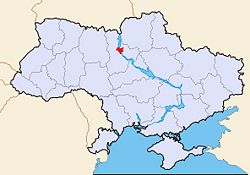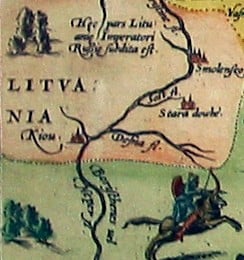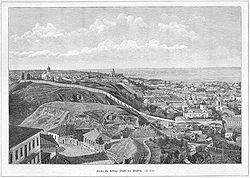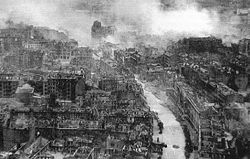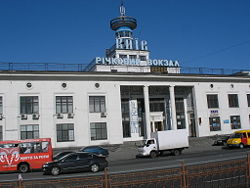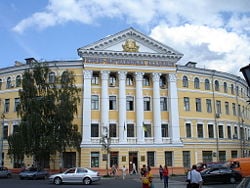Difference between revisions of "Kyiv" - New World Encyclopedia
Mike Butler (talk | contribs) |
Mike Butler (talk | contribs) |
||
| Line 127: | Line 127: | ||
[[Image:Kiew prospBazhanaOst.jpg|thumb|right|250px|[[European route E40|E40]], the longest of all [[International E-road network|European routes]], going through Kiev.]] | [[Image:Kiew prospBazhanaOst.jpg|thumb|right|250px|[[European route E40|E40]], the longest of all [[International E-road network|European routes]], going through Kiev.]] | ||
[[Image:Kiev River Port 2007.JPG|thumb|right|250px|The [[Kiev River Port]].]] | [[Image:Kiev River Port 2007.JPG|thumb|right|250px|The [[Kiev River Port]].]] | ||
| − | [[Image:Tram K3R-N in Kyiv.jpg|thumb|right|250px|Kiev tram|Tram in Kiev | + | [[Image:Tram K3R-N in Kyiv.jpg|thumb|right|250px|Kiev tram|Tram in Kiev.]] |
After Russia, the Ukrainian republic was far and away the most important economic component of the former [[Soviet Union]], producing about four times the output of the next-ranking republic. Its fertile black soil generated more than one-fourth of Soviet agricultural output, and its farms provided substantial quantities of meat, milk, grain, and vegetables to other republics. Likewise, its diversified heavy industry supplied the unique equipment (for example, large diameter pipes) and raw materials to industrial and mining sites (vertical drilling apparatus) in other regions of the former USSR. | After Russia, the Ukrainian republic was far and away the most important economic component of the former [[Soviet Union]], producing about four times the output of the next-ranking republic. Its fertile black soil generated more than one-fourth of Soviet agricultural output, and its farms provided substantial quantities of meat, milk, grain, and vegetables to other republics. Likewise, its diversified heavy industry supplied the unique equipment (for example, large diameter pipes) and raw materials to industrial and mining sites (vertical drilling apparatus) in other regions of the former USSR. | ||
| Line 140: | Line 140: | ||
Kiev is notable in the world of aviation industry as the headquarters for [[Antonov|Antonov aircraft manufacturing company]]. | Kiev is notable in the world of aviation industry as the headquarters for [[Antonov|Antonov aircraft manufacturing company]]. | ||
| + | Kiev has a developed railroad infrastructure including a long-distance passenger station, six cargo stations, depots, and repairing facilities, although this system still fails to meet the demand for passenger service. | ||
| − | Kiev | + | Railways and all-weather roads link Kiev to [[Moscow]], [[Kharkiv]], which is Ukraine's second largest city, to the port of Odessa, to southern and western Ukraine, and to Poland. |
[[Boryspil Airport]] serves many international airlines, and the smaller [[Kyiv-Zhulyany Airport|Zhulyany Airport]], serves mostly domestic flights and limited flights to nearby countries. | [[Boryspil Airport]] serves many international airlines, and the smaller [[Kyiv-Zhulyany Airport|Zhulyany Airport]], serves mostly domestic flights and limited flights to nearby countries. | ||
Revision as of 07:54, 16 December 2008
| Kyiv Київ Kiev |
|||
| Kiev, an old and a modern city. A construction crane and the towers of the Kiev Monastery of the Caves. | |||
|
|||
| Map of Ukraine with Kiev highlighted | |||
| Coordinates: {{#invoke:Coordinates|coord}}{{#coordinates:50|27|00|N|30|31|24|E|type:city | |||
|---|---|---|---|
| name= }} | |||
| Country | |||
| Municipality | Kiev City Municipality | ||
| Raions | List of 10
|
||
| Government | |||
| - Mayor | Leonid Chernovetskyi | ||
| Elevation | 179 m (587 ft) | ||
| Population (April, 2007) | |||
| - Total | 2.7 million (official est.) | ||
| - Density | 3,299/km² (8,544.4/sq mi) | ||
| Time zone | EET (UTC+2) | ||
| - Summer (DST) | EEST (UTC+3) | ||
| Postal code | 01xxx-04xxx | ||
| Area code(s) | +380 44 | ||
| License plate | AA (before 2004: КА,КВ,КЕ,КН,КІ,KT) | ||
| Sister cities | Ankara, Athens, Belgrade, Brussels, Budapest, Chicago, Chişinău, Edinburgh, Florence, Helsinki, Kraków, Kyoto, Leipzig, Minsk, Munich, Odense, Paris, Pretoria, Riga, Rome, Santiago de Chile, Sofia, Stockholm, Tallinn, Tampere, Tbilisi, Toronto, Toulouse, Warsaw, Wuhan, Vienna, Vilnius, Pereira, Yerevan |
||
| Website: http://www.kmr.gov.ua | |||
Kiev, also known as Kyiv (Ukrainian: Київ ▶, Kyiv, IPA: [ˈkɪjiw]; Russian: Ки́ев ▶, Kiyev; see also Cities' alternative names), is the capital and the largest city of Ukraine, located in the north central part of the country on the Dnieper River.
Kiev is an important industrial, scientific, educational and cultural centre of Eastern Europe. It is home to many high-tech industries, higher education institutions and world-famous historical landmarks. The city has an extensive infrastructure and highly developed system of public transport, including the Kiev Metro.
Founded in the fifth century as a trading post, it acquired eminence in the 10th to 12th centuries a capital of Rus', a medieval East Slavic state. Destroyed during the Mongol invasion in 1240, it was a provincial capital of marginal importance until the city prospered during the Russian industrial revolution in the late 19th century. From 1934, Kiev was the capital of the Ukrainian Soviet Socialist Republic, and, from 1934. During World War II, the city suffered significant damage, but recovered, remaining the third largest city of the Soviet Union, to become, after independence in 1991, Kiev remained the capital of Ukraine.
Geography
Geography The name Kiev is said to derive from the name of Kyi, one of four legendary founders of the city (brothers Kyi, Shchek, Khoryv and sister Lybid'). Kiev is the traditional and most commonly used English name for the city,[1] but since the 1995 adoption of Kyiv by the Ukrainian government as a preferred spelling, the Ukrainianized version Kyiv is gaining usage.
Kiev is located on both sides of the Dnieper River, which flows south through the city towards the Black Sea. The older right-bank (western) part of the city is represented by numerous woody hills, ravines and small rivers. It is a part of the larger Dnieper Upland adjoining the western bank of the Dnieper in its mid-flow. Kiev expanded to the Dnieper's lowland left bank (to the east) only in the 20th century. Significant areas of the left-bank Dnieper valley were artificially sand-deposited, and are protected by dams.
The Dnieper River forms a branching system of tributaries, isles, and harbors within the city limits. The city is adjoined by the mouth of the Desna River and the Kiev Reservoir in the north, and the Kaniv Reservoir in the south. Both the Dnieper and Desna rivers are navigable at Kiev, although regulated by the reservoir shipping locks and limited by winter freeze-over.
Elevation
Kiev has a continental humid climate. The average maximum daytime temperature in January of 24.8°F (-4°C), rising to an average maximum of around 77°F (25°C) in July. Snow cover usually lies from mid-November to the end of March, with the frost-free period lasting 180 days on average, but surpassing 200 days in recent years. Average annual precipitation is 26.6 inches (677mm).
Size – land area, size comparison Environmental issues Districts
History
Kiev is one of the oldest and most important cities of Eastern Europe and has played a pivotal role in the development of the medieval East Slavic civilization as well as in the modern Ukrainian nation.
Human settlement at the site of the present day city may have occurred as early as the fifth or the sixth century AD.[2] With the exact time of city foundation being hard to determine, May 1982 was chosen to celebrate the city's 1,500th anniversary.
During the eighth and ninth centuries, Kiev was an outpost of the Khazar empire. Starting in the late ninth century Kiev was ruled by the Varangian nobility and became the nucleus of the Rus' polity, whose Golden Age (eleventh to early twelfth centuries) has from the nineteenth century become referred to as Kievan Rus'. In 1240 the Mongol invasion of Rus led by Batu Khan completely destroyed Kiev, an event that had a profound effect on the future of the city and the East Slavic civilization. At the time of the Mongol destruction, Kiev was reputed as one of the largest cities in the world, with a population exceeding one hundred thousand.
In 1321, the greatly diminished city and surrounding area was conquered by Gediminas for the Grand Duchy of Lithuania. From 1569 the city was controlled by the Polish-Lithuanian Commonwealth, as a capital of Kijów Voivodeship, transferred by then to the Polish Crown. In the 17th century, Kiev was transferred under rule of Russia. In the Russian Empire Kiev was a primary Christian centre, attracting pilgrims, and the cradle of many of the empire's most important religious figures, but until the 19th century the city's commercial importance remained marginal.
Kiev prospered again during the late nineteenth century industrial revolution in the Russian Empire, when it became the third most important city of the Empire and the major centre of commerce of its southwest. In the turbulent period following the 1917 Russian Revolution, Kiev became the capital of several short-lived Ukrainian states and was caught in the middle of several conflicts: World War I, the Russian Civil War, and the Polish-Soviet War. Kiev changed hands sixteen times from the end of 1918 to August 1920.[3]
From 1921 the city was a part of the Ukrainian Soviet Socialist Republic, a founding republic of the Soviet Union. Kiev was greatly affected by all the major processes that took place in Soviet Ukraine during the interwar period: the 1920s Ukrainization as well as the migration of the rural Ukrainophone population made the recently Russophone city partly Ukrainian-speaking and propped up the development of the Ukrainian cultural life in the city; the Soviet Industrialization that started in end-1920s turned the city, a former centre of commerce and religion, into a major industrial, technological and scientific centre, the 1932-1933 Great Famine devastated the part of the migrant population not registered for the ration cards, and Stalin's 1930s Great Purge almost eliminated the city's intelligentsia
In 1934 Kiev became the capital of Soviet Ukraine. The city boomed again during the years of the Soviet industrialization as its population grew rapidly and many industrial giants were created, some of which exist to this day.
In World War II, the city again suffered significant damage, but quickly recovered in the post-war years, becoming once again the third most important city of the Soviet Union. The catastrophic accident at the Chernobyl Nuclear Power Plant occurred only 100 km north of the city. However, the prevailing northward winds blew the most substantial radioactive debris away from the city.
In the wake of the collapse of the Soviet Union the Declaration of Independence of Ukraine was proclaimed in the city by the Ukrainian parliament on August 24, 1991. Kiev is the capital of independent Ukraine.
Government
The municipality of the city of Kiev has a special legal status within Ukraine compared to the other administrative subdivisions of the country. The most significant difference is that the city is subordinated directly to the national-level branches of the Government of Ukraine, skipping the regional level authorities of Kiev Oblast. Additionally, the Head of City Administration — the leading executive position is held by a directly elected, rather than appointed, figure, who is also the Head of City Council — the Mayor of Kiev, and municipal institutions have a higher level of self governance than elsewhere in Ukraine.
Subdivisions
Formal subdivision
Administratively, the city is divided into "raions" ("districts"), which have their own locally elected governments with jurisdiction over a limited scope of affairs. Presently, there are 10 raions.
Informal subdivision
The Dnieper River naturally divides Kiev into the Right Bank and the Left Bank areas. Historically located on the western right bank of the river, the city expanded into the left bank only in the twentieth century. Most of the Kiev's attractions as well as the majority of business and governmental institutions are located at the right bank. The eastern Left Bank is predominantly residential. There are large industrial and green areas in both the Right Bank and the Left Bank.
Kiev is further informally divided into historical or territorial neighborhoods, each housing from about 5,000 to 100,000 inhabitants.
- See also: Category:Neighborhoods and raions of Kiev
Economy
After Russia, the Ukrainian republic was far and away the most important economic component of the former Soviet Union, producing about four times the output of the next-ranking republic. Its fertile black soil generated more than one-fourth of Soviet agricultural output, and its farms provided substantial quantities of meat, milk, grain, and vegetables to other republics. Likewise, its diversified heavy industry supplied the unique equipment (for example, large diameter pipes) and raw materials to industrial and mining sites (vertical drilling apparatus) in other regions of the former USSR.
Per capita GDP was estimated at $7000 in 2007.
Financial and business services sector
Tourism
Manufacturing
Kiev is notable in the world of aviation industry as the headquarters for Antonov aircraft manufacturing company.
Kiev has a developed railroad infrastructure including a long-distance passenger station, six cargo stations, depots, and repairing facilities, although this system still fails to meet the demand for passenger service.
Railways and all-weather roads link Kiev to Moscow, Kharkiv, which is Ukraine's second largest city, to the port of Odessa, to southern and western Ukraine, and to Poland.
Boryspil Airport serves many international airlines, and the smaller Zhulyany Airport, serves mostly domestic flights and limited flights to nearby countries.
Public transportation in Kiev includes the metro (underground), buses, trolleybuses, trams, and and short-range trains known as elektrichkas. One unique mode of public transportation Kiev has is the funicular, that climbs up the steep right bank of the Dnieper River. It transports 10,000 to 15,000 passengers daily. Privately owned minibuses, marshrutkas, have appeared on Kiev streets, and provide good coverage of smaller residential streets and have convenient routes. The taxi market in Kiev is expansive but not adequately regulated.
Demographics
As of April 2007, official municipal estimates placed the population of Kiev at about 2.7 million inhabitants, although some much higher unofficial estimates are often published.[4]
Race/ethnicity - historical background of ethnic groups Language Religion
Kiev hosts many universities, the major ones being Kiev National Taras Shevchenko University,[5] the National Technical University "Kiev Polytechnic Institute",[6] and the Kyiv-Mohyla Academy.[7] The total number of institutions of higher education in Kiev approaches 200,[8].
Template:Histpop
As of the All-Ukrainian Census conducted on December 5, 2001, the population of Kiev is 2,611,300.[4] The historic changes in population is shown in the side table. According to the census, men accounted for 1,219,000 persons, or 46.7%, and women for 1,393,000 persons, or 53.3%. Comparing the results with the previous census (1989) shows the trend of population aging which, while prevalent throughout the country, is partly offset in Kiev by the inflow of working age migrants.
According to the census data, more than 130 nationalities and ethnic groups reside within the territory of Kiev. Ukrainians constitute the largest ethnic group in Kiev, and they account for 2,110,800 people, or 82.2% of the population. Russians comprise 337,300 (13.1%), Jews 17,900 (0.7%), Belarusians 16,500 (0.6%), Poles 6,900 (0.3%), Armenians 4,900 (0.2%), Azerbaijanis 2,600 (0.1%), Tatars 2,500 (0.1%), Georgians 2,400 (0.1%), Moldovans 1,900 (0.1%).
Both Ukrainian and Russian are commonly spoken in the city, with Russian being more widely used despite the fact that Ukrainian is claimed as their native language by almost three times as many residents as those who claim Russian.[9] According to a 2006 survey, Ukrainian is used at home by 23% of Kievans, as 52% use Russian and 24% switch between both.[10]
Some 1,069,700 people have higher or completed secondary education, a significant increase of 21.7% since 1989.
The latest (April, 2007) municipal estimate of the city population is of 2.7 million residents.[4] Other much higher estimates are often published. For instance, the amount of bakery products sold in the city (thus including temporary visitors and commuters) gives a minimum of 3.5 million people (June, 2007).[4]
Modern Kiev
Modern Kiev is a mix of the old and the new, seen in everything from the architecture to the stores and to the people themselves. Experiencing great population growth between the 1970s and the mid-'90s, the city has continued its consistent growth after the turn of the millennium. As a result, Kiev's "downtown" is a dotted contrast of new, modern buildings amongst the pale yellows, blues and grays of older apartments. Urban sprawl has gradually reduced, while population densities of suburbs has increased. The most expensive properties are located in the Pechersk, and Khreshchatyk areas. It is also prestigious to own a property in newly constructed buildings in the Kharkivskyi Raion or Obolon along the Dnieper.
Ukrainian independence at the turn of the millennium has heralded other changes. Western-style residential complexes, modern nightclubs, classy restaurants and prestigious hotels opened in the centre. Music from Europe and North America started appearing on Ukrainian music charts. And most importantly, with the easing of the visa rules in 2005,[11] Ukraine is positioning itself as a prime tourist attraction, with Kiev, among the other large cities, looking to profit from new opportunities. The centre of Kiev has been cleaned up and buildings have been restored and redecorated, especially the Khreshchatyk street and the Independence Square. Many historic areas of Kiev, such as Andriyivskyy Descent, have become popular street vendor locations, where one can find traditional Ukrainian art, religious items, books, game sets (most commonly chess) as well as jewelry for sale.[12]
Culture
A historic cultural centre of the East Slavic civilization and a major cradle of Christianization for what became the Belarusian, Russian and Ukrainian nations, Kiev retained through centuries its cultural importance and even at times of relative decay, it remained the centre of the Eastern Orthodox Christianity of the primary importance. It's holy sites, of which the Kiev Pechersk Lavra (the Monastery of the Caves) and the Saint Sophia Cathedral are probably the most famous, attracted pilgrims for centuries and now recognized as a UNESCO World Heritage Site remain the primary religious centres as well as the major tourist attraction. The above mentioned sites are also part of the Seven Wonders of Ukraine collection.
An important part of Kiev's culture is the many theatres in the city, which include: Kiev Opera House, Ivan Franko National Academic Drama Theater, Lesya Ukrainka National Academic Theater of Russian Drama, the Kiev Puppet Theater, October Palace, National Philharmonic of Ukraine and many others.
Other cultural items include the Dovzhenko Film Studios, and the Kiev Circus. The most important of the city's many museums are the Kiev State Historical Museum, Museum of the Great Patriotic War, the National Art Museum, the Museum of Western and Oriental Art and the National Museum of Russian art.
In 2005 Kiev hosted the 50th annual Eurovision Song Contest as a result of Ruslana's Wild Dances being victorious in 2004.
- See also: Category:Kiev city culture
Sports
Football is the most popular spectator sport in Kiev, followed by basketball and ice hockey. Kiev has many professional and amateur football clubs, including the Arsenal and Dynamo, which both play in the top division of the Ukrainian Premier League. Other less prominent sport clubs in the city include: the FC Obolon Kyiv soccer club, the Sokil Kyiv hockey club and BC Kyiv basketball club.
During the 1980 Summer Olympics held in the Soviet Union, Kiev held the preliminary matches and the quarter-finals of the football tournament at its Olympic Stadium, reconstructed for the event. The stadium is the largest of Ukrainian stadiums, as well as among Kiev's 15 stadiums/sport complexes. Initially constructed for audience of 100,000, following the installation of individual seats it can now accommodate 83,053 spectators. Other notable sport stadiums/sport complexes in Kiev include the Lobanovsky Dynamo Stadium, the Palace of Sports, among many others.
Kiev does not only host field games and indoor sports, but also aquatic sports, which take place on the Kiev Reservoir at Vyshhorod, and on Trukhaniv Island in the Dnieper river, opposite the city centre, where there are many fine beaches and recreational facilities. In addition to that, cross country bicycling is another favourite sport, also taking place on the Trukhaniv Island.
Together with a few other cities of Poland and Ukraine, Kiev will house the 2012 UEFA European Football Championship. Three group matches, a quarter final and the final are scheduled to be played at Kiev NSK Olimpiyskyi stadium.
- See also: Category:Sport in Kiev
Architecture
Kiev's most famous historical architecture complexes are the St. Sophia Cathedral and the Kiev Pechersk Lavra (Monastery of the Caves), which are recognized by UNESCO as a World Heritage Site.
Noteworthy historical architectural landmarks also include the Mariyinsky Palace (designed and constructed from 1745 to 1752, then reconstructed in 1870), several Orthodox churches such as St. Michael's Cathedral, St. Andrew's, St. Vladimir's, the reconstructed Golden Gate and others.
One of Kiev's widely recognized modern landmarks is the highly visible giant Mother Motherland statue standing at the Museum of the Great Patriotic War on the Right bank of the Dnieper River. Other notable sites is the cylindrical Salut hotel, located across from Glory Square and the eternal flame at the World War Two memorial Tomb of the Unknown Soldier, and the House with Chimaeras.
Among Kiev's best-known monuments are Mikeshin's statue of Bohdan Khmelnytsky astride his horse located near St. Sophia Cathedral, the venerated Vladimir the Great (St. Vladimir), the baptizer of Rus', overlooking the river above Podil, the monument to Kyi, Schek and Khoryv and Lybid, the legendary founders of the city located at the Dnieper embankment. On Independence Square in the city centre, two tall columns elevate two modern monuments of the city protectors; the historic protector of Kiev Michael Archangel and a modern invention, the goddess-protector Berehynia.
- See also: Category:Buildings and structures in Kiev
Architectural monuments
- Verkhovna Rada Ukrainy.jpg
Verkhovna Rada building, the Ukrainian parliament.
Tourism
Attractions in Kiev
It is said that one can walk from one end of Kiev to the other in the summertime without leaving the shade of its many trees. Most characteristic are the horse-chestnuts (Ukrainian: каштани, kashtany).
Kiev is known as a green city with two botanical gardens and numerous large and small parks. The green nature of the city is probably most notable by the green hills of the right bank along the Dnieper river that have been relatively untouched by development. The World War II Museum is located here, which offers both indoor and outdoor displays of military history and equipment surrounded by verdant hills overlooking the Dnieper river.
Among the numerous islands, Venetsianskyi (or Hidropark) is the most developed. It is accessible by metro or by car, and includes an amusement park, swimming beaches, boat rentals, and night clubs. The Victory Park (Park Peremohy) located near Darnytsia subway station is a popular destination for strollers, joggers, and cyclists.
Boating, fishing, and water sports are popular pastimes in Kiev. The area lakes and rivers freeze over in the winter and ice fishermen are a frequent sight, as are children with their ice skates. However, the peak of summer draws out a greater mass of people to the shores for swimming or sunbathing, with daytime high temperatures sometimes reaching 30 to 34 °C (86–93 °F).
The centre of Kiev (Independence Square and Khreschatyk Street) becomes a large outdoor party place at night during summer months, with thousands of people having a good time in nearby restaurants, clubs and outdoor cafes. The central streets are closed for auto traffic on weekends and holidays.
Andriyivskyy Descent is one of the best known historic streets and a major tourist attraction in Kiev. The descent is the site of the Castle of Richard Lionheart; the baroque-style St Andrew's Church ; the home of a a famous Kiev-born writer, Mikhail Bulgakov, the monument to Yaroslav the Wise, the Grand Prince of Kyiv and of Novgorod and numerous other monuments.[13][14]
A wide variety of farm produce is available in many of Kiev's farmer markets with the Besarabsky Market located in the very centre of the city being most famous. Each residential region has its own market, or rynok. Here one will find table after table of individuals hawking everything imaginable: vegetables, fresh and smoked meats, fish, cheese, honey, dairy products such as milk and home-made smetana (sour cream), caviar, cut flowers, housewares, tools and hardware, and clothing. Each of the markets has its own unique mix of products with some markets devoted solely to specific wares such as automobiles, car parts, pets, clothing, flowers, etc.. There is also a popular book market by the Petrivka metro station.
At the city's southern outskirts, near the historic Pyrohiv village, there is an outdoor museum, officially called the Museum of Folk Architecture and Life of Ukraine It has an area of 1.5 square kilometers (1 sq mi). This territory houses several "mini-villages" that represent by region the traditional rural architecture of Ukraine.
Kiev also has numerous recreational attractions like bowling alleys, go-cart tracks, paintball venues, billiard halls and even shooting ranges. 100-year-old Kiev Zoo is located on 40 hectares and carries over 2,000 specimens.
- See also: Category:Visitor attractions in Kiev
Economy
Template:Rewrite-section {{#invoke:Message box|ambox}}
Kiev, as the capital of Ukraine, is a major administrative centre housing amongst others ministries responsible for the economy of the country. Factories in Kiev are found in all parts of the city, with a major concentration of industrial organizations to the west of the city centre and on the left bank of the Dnieper River.[citation needed]
- See also: Category:Economy of Kiev, Economy of Ukraine
Industrial organizations
The Kiev engineering plants manufacture their equipment utilizing metal from the iron and steel areas of Dnipropetrovshchyna and the Donbas coalfield[citation needed]. These plants in Kiev make equipment for chemical plants, such as conveyor lines for vulcanized rubber, linoleum, fertilizer factories, and also metal-cutting machines. Other engineering products of Kiev area include aircraft (see: Antonov), hydraulic elevators, electrical instruments, armatures, river-and-sea crafts, motorcycles, and cinematography equipment.
Another important sector is the chemical industry, which produces resin products, fertilizers, plastics, and chemical fibers, made at the Darnytsky Raion viscose plant on the left bank of Kiev. Lumber milling[citation needed] and the production of bricks and reinforced concrete items are another well developed industry. Consumer manufactured goods include cameras (see: Kiev-Arsenal (photo camera), thermos flasks, knitwear, footwear, a range of foodstuffs, and hand watches[citation needed]. Kiev is also a large publishing centre.
Power production
{{#invoke:Message box|ambox}} Kiev is supplied by electricity primary from the Kiev Hydroelectric Power Station, completed in 1968, just upstream of the city at Vyshhorod, on the Kiev Reservoir, and from Trypillia thermal electric station. Following the Chernobyl accident the Chernobyl Nuclear Power Plant located 100 km north of Kiev has been closed. Kiev also receives its power supply in the form of natural gas, piped from Urengoy-Pomary-Uzhhorod pipeline.
See also
ReferencesISBN links support NWE through referral fees
- ↑ As of 2008, the Oxford English Dictionary includes 19 quotations with 'Kiev' and none with any other spelling. This spelling is also given by Britannica and Columbia Encyclopedia.
- ↑ There are no known historical records as to the founding dates of the city. The Kiev article in Encyclopedia Britannica states: "The village that became the modern city may have been founded as early as the 6th century AD." The Columbia Encyclopedia in Kiev states: "It probably existed as a commercial centre as early as the 5th cent."
- ↑ Eksteins, Modris (1999). Walking Since Daybreak. Houghton Mifflin. ISBN 061808231X.
- ↑ 4.0 4.1 4.2 4.3 The most recent Ukrainian census, conducted on December 5, 2001, gave the population of Kiev as 2611.3 thousand (Ukrcensus.gov.ua - Kyiv city URL accessed on August 4, 2007). Estimates based on the amount of bakery products sold in the city (thus including temporary visitors and commuters) suggest a minimum of 3.5 million. "There are up to 1.5 mln of undercounted residents in Kiev", Korrespondent.net, June 15, 2005. (Russian)
- ↑ See also:Kiev University official website URL accessed on July 28, 2006
- ↑ See also: KPI official website URL accessed on July 28, 2006
- ↑ See also: Kyiv-Mohyla Academy official website URL accessed on July 28, 2006
- ↑ See also: Osvita.org URL accessed on June 20, 2006
- ↑ According to the official 2001 census data [1][2] approximately 75% of Kiev's population responded 'Ukrainian' to the native language (ridna mova) census question, and roughly 25% responded 'Russian'. On the other hand, when the question 'What language do you use in everyday life?' was asked in the 2003 sociological survey, the Kievans' answers were distributed as follows: 'mostly Russian': 52%, 'both Russian and Ukrainian in equal measure': 32%, 'mostly Ukrainian': 14%, 'exclusively Ukrainian': 4.3%.
"What language is spoken in Ukraine?", Welcome to Ukraine, 2003/2.. - ↑ "Kiev: the city, its residents, problems of today, wishes for tomorrow.", Zerkalo Nedeli, April 29 - May 12, 2006. in Russian, in Ukrainian
- ↑ Workpermit.com ULR accessed on July 30, 2006
- ↑ Kiev.info URL accessed on June 20, 2006
- ↑ Andreyevskiy Spusk (in English). Hotels-Kiev.com. Optima Tours. Retrieved June 20, 2006.
- ↑ Andreevsky spusk (in Russian). Kyiv Guide. Retrieved June 20, 2006.
External links
General
- Encyclopaedia Britannica Kiev Retrieved December 16, 2008.
- World Fact Book 2008 Ukraine Retrieved December 16, 2008.
- BBC weather city guides Kiev Retrieved December 16, 2008.
- Official Kiev city administration webportal
- Kyiv.com Official City Website
- Kiev sites catalogue
- Weather on Kiev
- Kiev weather forecast
- Pictures of Kiev Sights of Kiev from Sergey Sorokin - private mountain guide
- Kiev & Kiev From Above - additional views of the city centre
- KievUA webportal
- Kiev in Old Postcards
- Travel guide to Kyiv from Wikitravel
- - The unususal view on Kyiv by the international journalists' team (English)
Kiev or Kyiv? Official documents:
- Kiev or Kyiv? - Resolution of the Ukrainian commission for legal terminology
- U.S. Board of Geographic Names Decision to Change Official Spelling of Kiev to Kyiv
Non-official documents:
- Kiev or Kyiv? Turin or Torino? — CBC News article about use of city names
- Fred Weir, Kiev or Kyiv: language an issue in Ukraine, The Christian Science Monitor, June 28, 2000
| Preceded by: Istanbul 2004 |
Eurovision Song Contest Hosts Kyiv 2005 |
Succeeded by: Athens 2006 |
|
Template:Seven Wonders of Ukraine Template:Subdivisions of Kiev Template:Administrative divisions of Ukraine
| ||||||
Credits
New World Encyclopedia writers and editors rewrote and completed the Wikipedia article in accordance with New World Encyclopedia standards. This article abides by terms of the Creative Commons CC-by-sa 3.0 License (CC-by-sa), which may be used and disseminated with proper attribution. Credit is due under the terms of this license that can reference both the New World Encyclopedia contributors and the selfless volunteer contributors of the Wikimedia Foundation. To cite this article click here for a list of acceptable citing formats.The history of earlier contributions by wikipedians is accessible to researchers here:
The history of this article since it was imported to New World Encyclopedia:
Note: Some restrictions may apply to use of individual images which are separately licensed.


